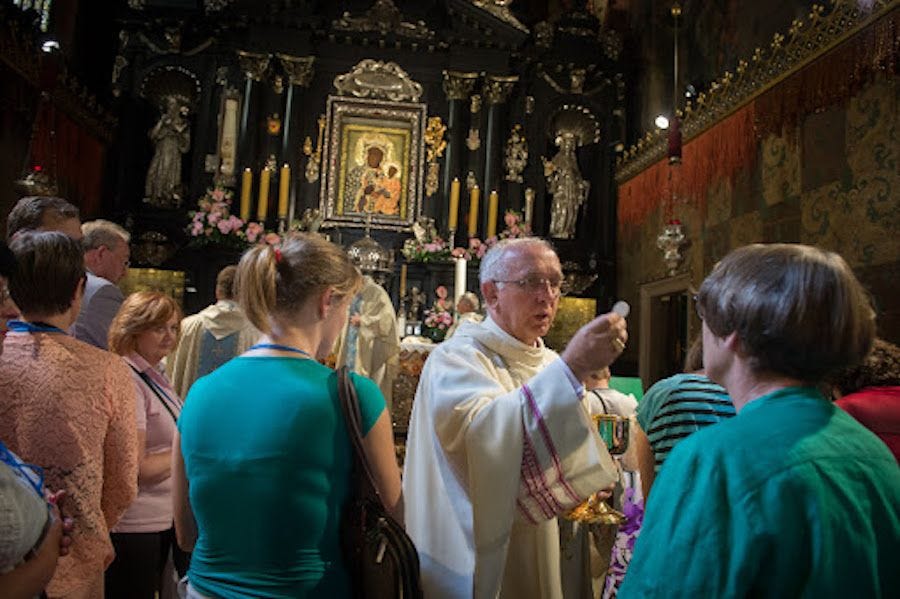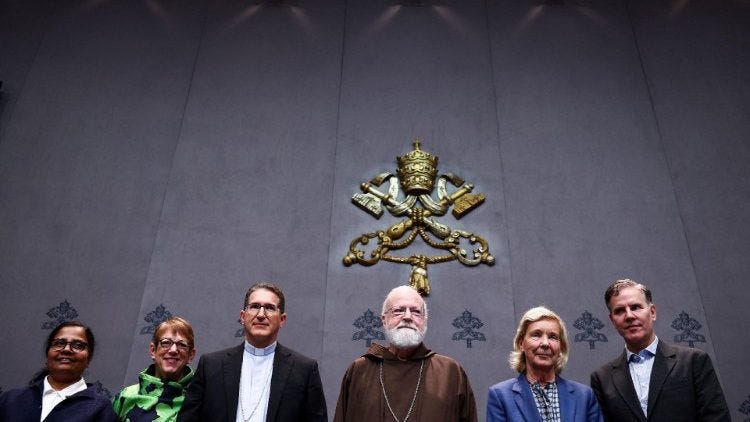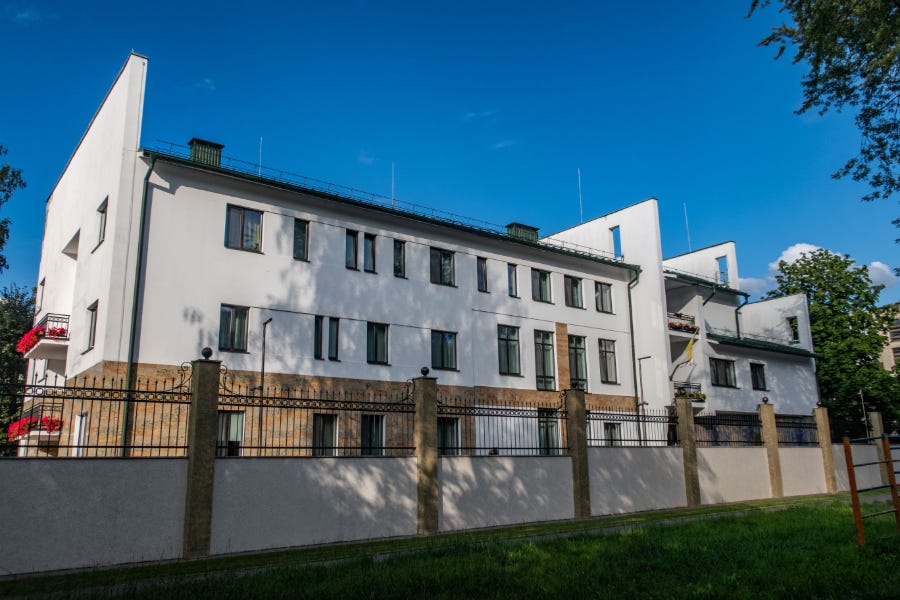Around 28% of Poland’s Catholics attended Mass in 2021, according to the latest official statistics.
The new figures were said to indicate a “dramatic fall” in church attendance in one of Europe’s most Catholic countries.
So, what does the new data say? How do researchers interpret it? And what is the Church doing in response to the decline? The Pillar takes a look.
What the figures say
On Jan. 13, the Institute for Catholic Church Statistics (ISKK) released its 2021 “Annuarium Statisticum Ecclesiae in Polonia,” a yearly numerical overview of Poland’s Catholic Church.
Since 1980, the institute has reported the percentage of “dominicantes” (Sunday Mass-goers) and “communicantes” (recipients of Holy Communion) out of the total number of baptized Catholics who are able to fulfill the obligation to attend weekly Mass on a given Sunday each year.
The ISKK’s annual study doesn’t give the actual number of dominicantes and communicantes per year, only the proportion.
Its latest report said that 28.3% were present at Sunday Mass when a headcount was taken on Sept. 26, 2021, while 12.9% received Communion.
This marked a notable drop compared to the last time the numbers were published in 2019 — no Sunday Mass figures were issued for the pandemic year of 2020.
In 2019, the figure for dominicantes was 36.9% and communicantes 16.7%, so the proportion of dominicantes fell by 8.6% and communicantes by 3.8% between 2019 and 2021.
The annual report breaks the statistics down by diocese. The diocese with the highest percentage of dominicantes and communicantes in 2021 is Tarnów, in southeastern Poland, with 59.1% and 21.9% respectively, while Szczecin-Kamień archdiocese, in northwestern Poland, recorded just 16.9% and 8.1% respectively. Tarnów is known as Poland’s “most religious” diocese, while Szczecin-Kamień is considered its least religious — testifying to wide regional disparities in religious practice.
The “Annuarium Statisticum Ecclesiae in Polonia” also contains figures for other sacraments. The latest report says that in 2021 there were 315,357 baptisms (compared to 312,082 in 2020), 331,744 first Holy Communions (297,951 in 2020), 265,681 confirmations (252,253 in 2020), and 103,807 Catholic weddings (91,468 in 2020).
Finally, the annual report offers a statistical profile of the Polish Church. In 2021, it says, the country had 10,352 Catholic parishes, 23,984 priests incardinated in dioceses, and 1,341 diocesan seminarians. Some 82% of students attended Church-run religion classes in the 2021-22 school year.
The Institute for Catholic Church Statistics tracks both Sunday Mass-goers and communicants, those who receive the Eucharist, as a percentage of Poland's Catholics:
What are researchers saying?
There is a tendency in the secular media to present every decline in Polish Catholic practice as a negative judgment on the Church’s stance on disputed political issues, such as the country’s abortion law and same-sex unions, as well as the clerical abuse crisis.
These are undoubtedly factors, but there was another very important influence on the 2021 Sunday Mass figures: the coronavirus pandemic.
The new report attaches a footnote to the 2021 dominicantes and communicantes figures. It notes that on the day the statistics were collected, Poland's COVID-19 restrictions were in place. Social distancing measures meant that Mass-goers were permitted to occupy half of all seats in churches (a limitation that did not apply to fully vaccinated people) and obliged to wear face coverings.
A press release on the Polish bishops’ conference website said that the data on dominicantes and communicantes for 2021 was therefore “not authoritative.” It added that the pandemic situation “clearly distorts the results.”
In remarks quoted by the Polish Press Agency, ISKK’s deputy director Marcin Jewdokimow said: “In previous years, the declines in the dominicantes index were constant. This time we’re dealing with a collapse. Therefore, I believe that next year we will have a rebound, the statistics will show an increase.”
He added: “In the long term, we are dealing with processes of socio-cultural changes. On the other hand, there is a certain reconfiguration of Catholicism and the place of religion in public space. People’s religious needs are changing and the way religious institutions function is changing.”
While the 2021 figures are undoubtedly striking, Poland still has one of the highest percentages of Sunday Mass attendance in Europe. While it’s hard to compare countries directly because of differences in presenting figures, the proportion of dominicantes is widely thought to be considerably higher in Poland than in other historically Catholic countries such as Spain, Italy, and France, as well as neighboring Germany.
The 2021 statistics also suggest that the Church bounced back after the intense disruption caused by the initial waves of COVID-19 in 2020. Baptisms, first Communions, confirmations, and Catholic weddings all rose year on year.
What is the Church doing?
Polish Church authorities are well aware of the decline in Sunday Mass attendance. Last November, they unveiled a new pastoral program for 2022-2023 entitled “I believe in the Church of Christ.”
Bishop Andrzej Czaja said that its purpose was to help Catholics “realize that despite the difficult issues, it is necessary to believe in the Church and trust in the Church.”
“To believe in the Church, because it is a Divine-human reality. To trust in the Church, because the Church is based on the authority of God Himself,” explained the bishop, who is chairman of the Polish bishops’ pastoral care commission.
The program has weekly topics up to November 2023, designed to promote greater commitment to Church life, including “Mass at the heart of Sunday” and “My engagement in the parish.”
Polish Catholic leaders will be hoping that the 2021 attendance figures prove to be a blip. But they are likely to be deeply concerned about other findings in the latest report.
The 2021 figure of 1,341 diocesan seminarians, for example, is a significant decrease from 2020, when there were 1,619. A sharp reduction in the number of secular priests would have major implications for the Church in Poland — and the whole continent, as one in four new Catholic priests in Europe is Polish.
And the fall in the percentage of students attending religion classes — from 85.7% in 2020 to 82.4% in 2021 — will also ring alarm bells, given how much Polish Catholicism’s vitality depends on the transmission of the faith from one generation to the next.




